Master the Cornell Note Taking Method
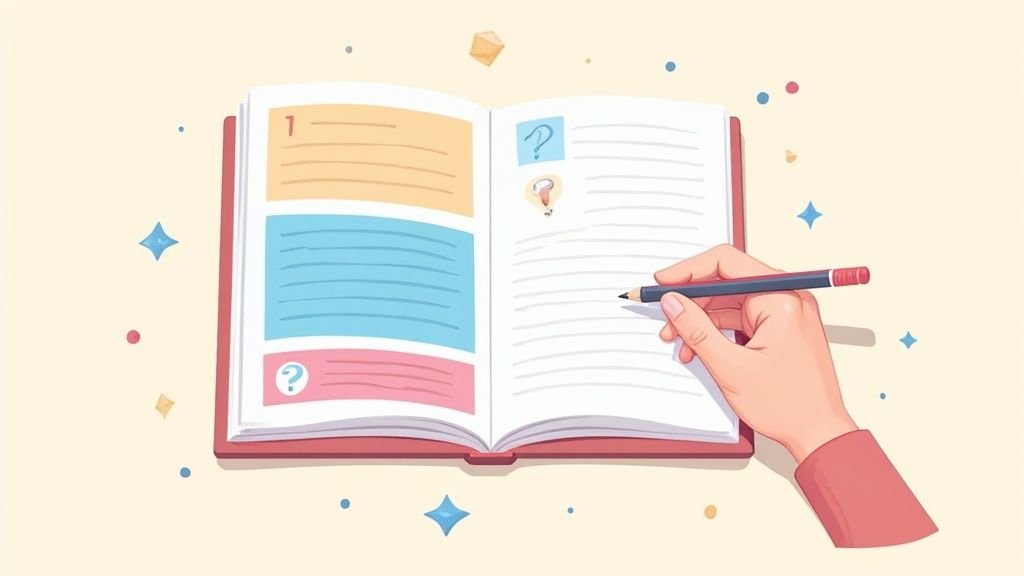
The Cornell note-taking method is more than just a specific page layout; it's a full-blown system for taking in, organizing, and actually remembering information. Think of it less like a blank page and more like a structured framework designed to make you engage with what you're hearing in real-time. It turns passive listening into an active process.
Breaking Down the Cornell Note Taking Method
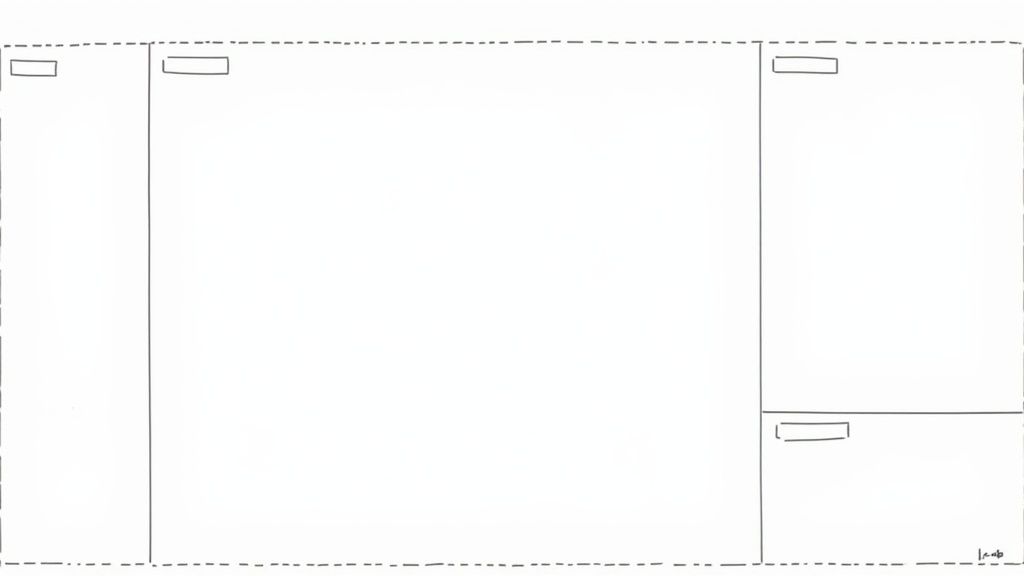
At its heart, the method is deceptively simple. It just divides a single page into three distinct sections, each with a specific job. This structure is what pushes you to question and synthesize information right from the start, instead of just mindlessly transcribing.
The system was originally cooked up by Walter Pauk, a professor at Cornell University back in the 1950s, who wanted to give his students a better way to retain what they learned. It worked. By the 2010s, it was so popular that over 80% of major U.S. universities were recommending it as a top-tier study strategy. If you're curious, you can learn more about its history and impact on academic practices.
The Three Zones of a Cornell Notes Page
The magic of the Cornell method really comes down to how it partitions the page. Each zone has a purpose, forcing you to interact with your notes in different ways at different times.
Let's break down the three sections.
Main Notes Area
Capture the key ideas and concepts from the lecture, meeting, or book.
During the session. This is for your initial, raw notes.
Cue Column
Pull out keywords, main ideas, or potential test questions from your main notes.
Right after the session, while the information is still fresh.
Summary Section
Distill the entire page of notes into one or two concise sentences.
After you've filled out the Cue Column, to solidify your understanding.
This clear separation is what makes the system so powerful. It builds a review process right into the note-taking itself.
This isn't just for students cramming for exams. In a professional setting, especially when using a tool like an Obsibrain template, this structure is perfect for organizing client meeting notes or project brainstorming sessions. In Obsibrain, you can capture action items in the cue column and then link them directly to a project's task list, ensuring key decisions and follow-ups are impossible to miss.
Why This Method Actually Improves Your Memory
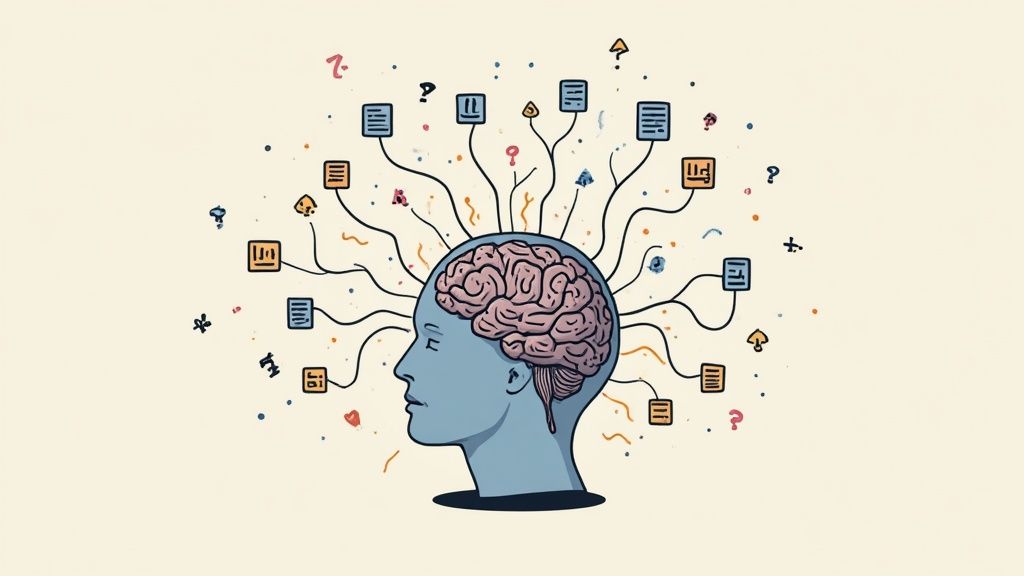
We’ve all been there. Information feels like it goes in one ear and right out the other. This frustrating experience is actually a well-documented phenomenon called the "forgetting curve," and the Cornell note-taking method is designed to fight it head-on.
Instead of just passively writing things down, this method forces you to truly engage with the material through built-in active recall and spaced repetition. It’s a complete shift in how you process information.
The real magic happens when you translate your detailed notes into short questions or keywords in the cue column. This simple step forces your brain to work harder, processing the information on a much deeper level and building stronger neural connections than just typing ever could.
This isn't just a neat trick; it's backed by solid research. Studies show that students who use this system just plain perform better. In fact, students taking notes by hand—a natural fit for this method—recalled about 27% more information than those typing everything verbatim. Even better, simply reviewing with the cue column and summary can cut information loss from a staggering 70% down to roughly 30% within just 24 hours.
From Passive Notes to Active Knowledge
When you summarize each page in your own words, you're not just taking notes anymore. You're cementing your understanding and creating a powerful, at-a-glance review tool for later. This fundamentally changes your relationship with the information, making sure it actually sticks.
The process of active engagement is a core principle of effective learning. It moves you from simply recognizing information to truly recalling it from memory, which is a much more demanding and effective cognitive exercise.
For example, using the Obsibrain template for Obsidian, you can schedule reviews of your summaries to pop up directly in your daily plan. This systematic approach is a game-changer for long-term retention, whether you're studying for an exam or preparing for a quarterly business review. You can learn more about setting up these valuable periodic reviews in your own workflow.
Building a Stronger Mental Framework
The Cornell method’s structure naturally helps organize your thoughts, making even the most complex topics feel more manageable. It gives you a reliable framework for learning that serves you long after the lecture is over.
Of course, this is just one piece of the puzzle. To really boost your cognitive toolkit, you can explore other powerful techniques. This guide on proven tips and strategies to improve working memory pairs perfectly with these note-taking habits, helping you build a truly robust system for learning.
Putting the Cornell Method into Action
So, you get the theory. But how does this actually work in practice? This is where the Cornell method really shines. It’s not just about writing stuff down; it’s a full-blown system built around five key actions—often called the "5 Rs"—that create a cycle of active learning.
Each step is designed to take you deeper, moving information from just-heard to deeply-understood.
It all kicks off the second you start taking notes. The first step is to Record everything in the main notes column. The goal here isn't to write a perfect transcript. Instead, focus on grabbing the big ideas, using whatever shorthand or abbreviations help you keep up.
Right after the lecture or meeting, it’s time to Reduce. This is a critical step. You’ll go back through your main notes and pull out the most important concepts, turning them into short questions or cues in the left-hand column. This simple act forces your brain to process the material and decide what truly matters.
This infographic breaks down those first, most active stages of the process.
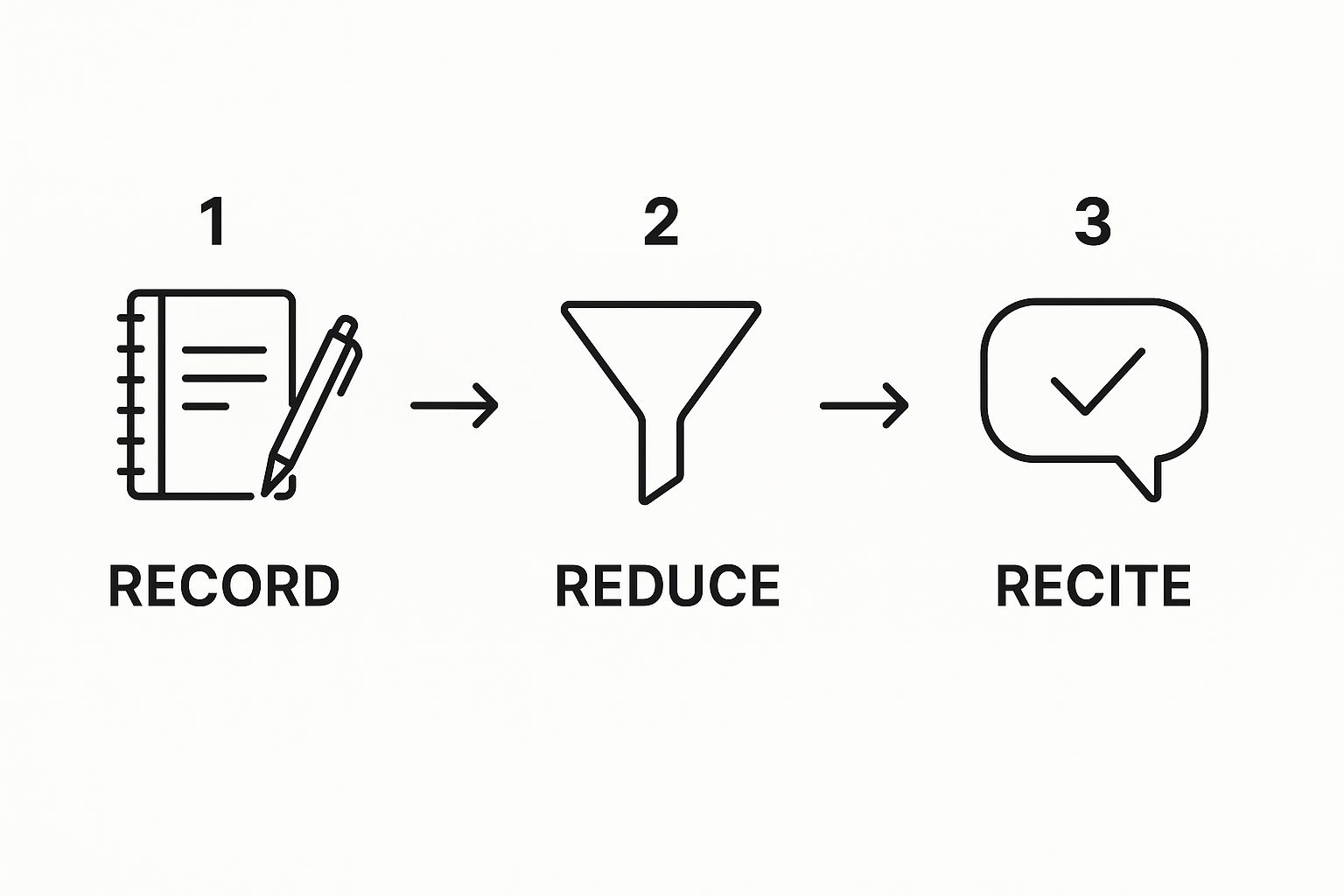
As you can see, it’s all about taking that raw stream of information, condensing it into powerful little triggers, and setting yourself up for active recall. It’s the difference between hearing something and truly engaging with it.
From Cues to Deep Understanding
Once your cues are in place, you move on to Recite. This is simple but powerful. Cover up the main notes section with your hand or a piece of paper and try to answer the questions you wrote in the cue column. Speaking the answers out loud is even better. This is self-testing 101, and it immediately shows you what you know and what you don’t.
Next, you Reflect. This is where the real magic happens and you start connecting the dots. Ask yourself: how does this new information fit with what I already know? Where have I seen this concept before? For anyone in academics, mastering this step can seriously help you improve your academic writing by building a more interconnected and evidence-based understanding.
Finally, make it a habit to Review your notes regularly. A quick, ten-minute scan every day can make a massive difference in retention. It’s a simple practice, but it's the key to beating the "forgetting curve" and making sure what you've learned actually sticks around.
Obsibrain Use Case: You can build a dedicated Cornell Notes template right inside Obsibrain. A great trick is to use the cue column to create backlinks to related concepts you've already captured. This turns every single note into a node in your personal knowledge graph. For example, a student could link a cue about "photosynthesis" to notes from biology, chemistry, and environmental science, making the "Reflect" step incredibly powerful. You can literally see how new ideas connect to your existing knowledge base.
Using Cornell Notes with Digital Tools Like Obsibrain
The Cornell method was born on paper, but it really comes alive when you pair it with modern digital tools. Its structured layout is a natural fit for a digital format, but the real magic happens when you add features a physical notebook just can't compete with. This is where a classic system gets a serious twenty-first-century upgrade.
Platforms like Obsibrain push this synergy even further by offering dedicated Cornell templates right out of the box. This gets rid of any setup friction, instantly giving you the three-zone layout so you can jump straight into capturing information. The real power, though, is how these notes become part of a larger, interconnected knowledge base.
Creating a Connected Digital Brain
In a traditional notebook, your cues and summaries are static words on a page. In Obsibrain, they transform into dynamic hubs of information. The cue column is no longer just a list of questions; it becomes a launchpad for creating backlinks. Each question or keyword can instantly link to dozens of other related ideas, lectures, or project notes scattered across your entire digital vault.
This simple act turns your notes from isolated documents into a living, breathing network of insights. For example, a single cue about a historical event could connect to notes from a completely different class, a book summary you wrote last month, and a current project plan, revealing patterns you would have otherwise missed.
This screenshot shows the Obsibrain Cornell Note Taking template in action.
As you can see, the familiar structure is clean and ready to go, but the embedded links and tags are where the system's power truly multiplies.
Supercharging Your Workflow
Going digital also dramatically improves the review and reflection stages of the Cornell method. Forget manually flipping through pages—you can search your entire note collection for a keyword in seconds. This makes finding specific information incredibly efficient. You can also use tags to categorize everything, making it a breeze to pull up all entries related to a single topic, like #ExamPrep or #ProjectAlpha.
The summary section gets a new lease on life, too. In Obsibrain, you can link your summary to broader "topic pages" or a project's main dashboard. For a project manager, this means the summary from a client call can be directly linked to the project's central hub note, creating a powerful, top-down view of your knowledge and ensuring all stakeholders have access to the latest key decisions.
This digital approach turns note-taking from a passive task into an active process of building a personal "second brain" that grows more valuable with every entry. For more ideas on weaving this into your daily routine, check out our guide on quick capture and notes to make sure no idea ever slips through the cracks. Fusing a time-tested method with smart digital tools creates a seriously robust system for learning and retention.
Taking Cornell Notes Beyond the Classroom
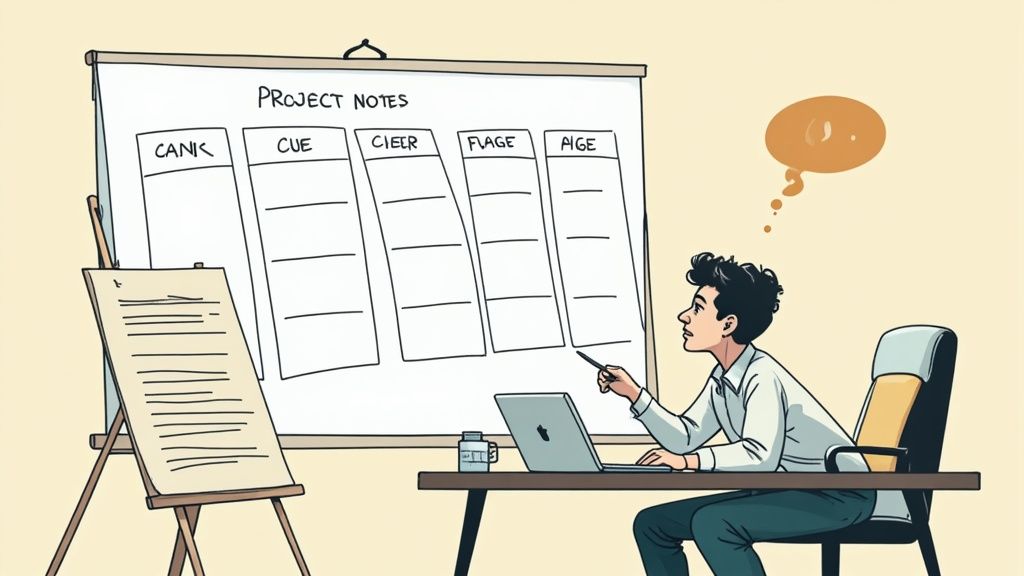
The real magic of the Cornell method is how well it works outside the classroom. For professionals, it's a total game-changer for wrangling complex information and making sure nothing gets missed. It brings a welcome sense of order to chaotic client meetings, project planning sessions, and workshop brainstorms.
Think about it: a jumbled discussion gets neatly transformed into clear, actionable insights. You use the main notes area for key takeaways, the cue column for specific action items, and the summary for final decisions. Suddenly, you have a reliable record that keeps projects moving forward.
From Projects to Personal Growth
The cornell note taking method is just as powerful for your own personal development. It doesn't matter if you're learning a new language, trying to master a coding framework, or just picking up a new skill—the system gives you a clear way to break down dense material into pieces you can actually digest. This makes review sessions way more focused and a lot less overwhelming.
For instance, when you're tackling a new subject, you can use the cue column to quickly jot down questions as they pop into your head. Inside Obsibrain, you can even turn these questions into backlinks, connecting them to other notes and building out your own personal web of knowledge.
This structured approach makes it so much easier to map out your learning journey. The goal is to build a system where every bit of information has a logical home, so your notes never turn into a disorganized digital mess.
Organizing Your Digital World with Obsibrain
To really get the most out of this, you need a coherent system that brings your professional and personal notes together. Obsibrain’s template structure is designed to do exactly that, helping you separate different areas of your life while keeping everything easy to find. This simple separation helps you stay focused and avoid mental whiplash from switching contexts.
You can learn more about creating this kind of powerful organizational framework by exploring the P.A.R.A. folder structure. It pairs perfectly with the Cornell method to create a truly organized digital workspace.
Of course, even a system as solid as the Cornell note taking method can leave you with a few questions. Let's tackle some of the common ones that pop up, so you can smooth out any wrinkles before you dive in.
One of the biggest questions is about going digital. Can you even use this method on a laptop or tablet? Absolutely. While it started on paper, digital tools are fantastic for it.
Apps with template features are a huge help here. For instance, the Obsibrain template for Obsidian instantly sets up the three-section layout for you. This doesn't just save a few seconds; it plugs you into powerful features like search, tagging, and linking that take the whole system to another level.
Going digital turns static notes into a dynamic, searchable knowledge base that grows with you.
Getting the Hang of Cues and Summaries
Another common sticking point is the cue column. What exactly are you supposed to write there? Think of this space as your personal set of memory triggers. After you’ve jotted down your notes in the main area, go back and ask yourself, "What question does this chunk of info answer?" or "What's the one keyword that captures this idea?" Your goal is to create little prompts that jog your memory without giving everything away.
But what if you run out of time to summarize your notes right after a class or meeting? Ideally, you want to write that summary within 24 hours to really lock in the information. But let's be realistic—doing it later is way better than skipping it entirely.
Try to carve out a few minutes each day to review and summarize. A quick sentence or two is all it takes to solidify the main ideas, which makes future review sessions so much more effective. In Obsibrain, you can even set a reminder to wrap up your summaries using the Daily Plan feature, helping turn a good intention into an unbreakable habit. It’s a simple trick to keep your notes organized and always ready for review.
Ready to stop just taking notes and start actively learning from them? The Obsibrain template for Obsidian has the Cornell Notes structure built right in, so you can get started in seconds. Start building your connected knowledge base today.
Last updated
Was this helpful?